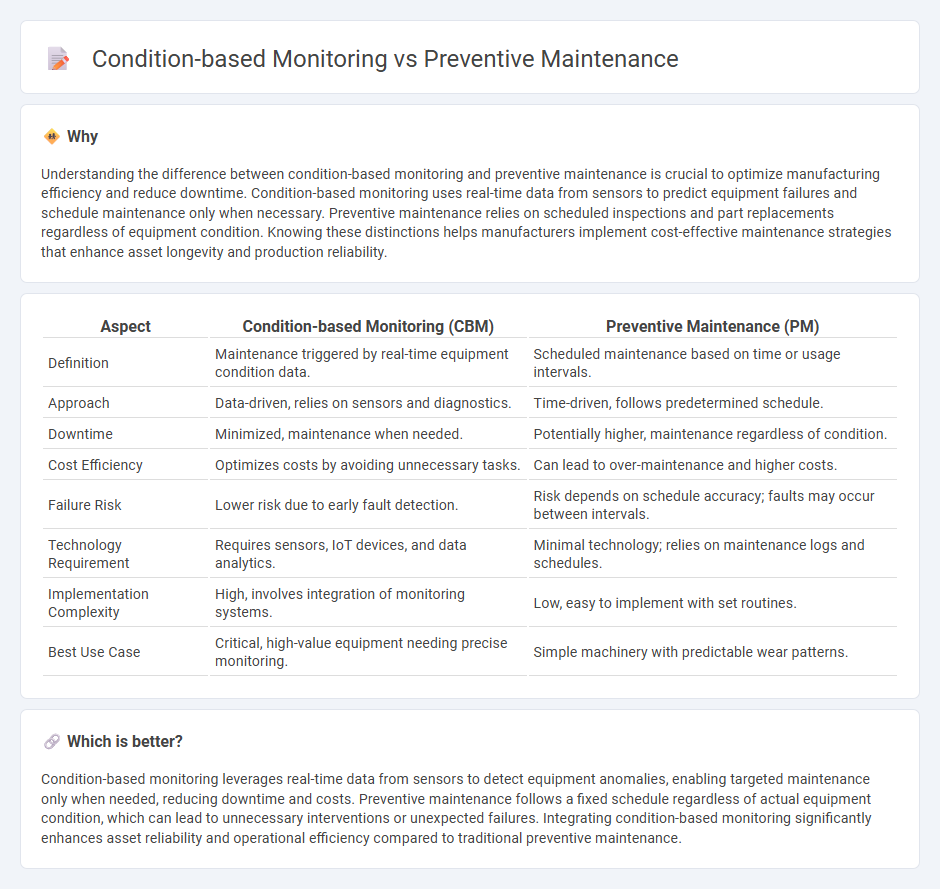
Condition-based monitoring uses real-time data and sensor technology to predict equipment failures, optimizing maintenance schedules and reducing downtime. Preventive maintenance relies on fixed intervals or usage limits to perform inspections and repairs, aiming to prevent breakdowns before they occur. Explore the advantages and applications of both strategies to enhance manufacturing efficiency.
Why it is important
Understanding the difference between condition-based monitoring and preventive maintenance is crucial to optimize manufacturing efficiency and reduce downtime. Condition-based monitoring uses real-time data from sensors to predict equipment failures and schedule maintenance only when necessary. Preventive maintenance relies on scheduled inspections and part replacements regardless of equipment condition. Knowing these distinctions helps manufacturers implement cost-effective maintenance strategies that enhance asset longevity and production reliability.
Comparison Table
| Aspect | Condition-based Monitoring (CBM) | Preventive Maintenance (PM) |
|---|---|---|
| Definition | Maintenance triggered by real-time equipment condition data. | Scheduled maintenance based on time or usage intervals. |
| Approach | Data-driven, relies on sensors and diagnostics. | Time-driven, follows predetermined schedule. |
| Downtime | Minimized, maintenance when needed. | Potentially higher, maintenance regardless of condition. |
| Cost Efficiency | Optimizes costs by avoiding unnecessary tasks. | Can lead to over-maintenance and higher costs. |
| Failure Risk | Lower risk due to early fault detection. | Risk depends on schedule accuracy; faults may occur between intervals. |
| Technology Requirement | Requires sensors, IoT devices, and data analytics. | Minimal technology; relies on maintenance logs and schedules. |
| Implementation Complexity | High, involves integration of monitoring systems. | Low, easy to implement with set routines. |
| Best Use Case | Critical, high-value equipment needing precise monitoring. | Simple machinery with predictable wear patterns. |
Which is better?
Condition-based monitoring leverages real-time data from sensors to detect equipment anomalies, enabling targeted maintenance only when needed, reducing downtime and costs. Preventive maintenance follows a fixed schedule regardless of actual equipment condition, which can lead to unnecessary interventions or unexpected failures. Integrating condition-based monitoring significantly enhances asset reliability and operational efficiency compared to traditional preventive maintenance.
Connection
Condition-based monitoring leverages real-time data from sensors to assess equipment health and detect anomalies, enabling timely maintenance interventions. Preventive maintenance uses this data-driven insight to schedule maintenance activities before failures occur, reducing downtime and extending machinery lifespan. Integrating these strategies enhances operational efficiency by transitioning from time-based to condition-driven maintenance, optimizing resource allocation in manufacturing.
Key Terms
Scheduled Intervals
Preventive maintenance relies on scheduled intervals to perform routine inspections and component replacements before failures occur, aiming to reduce unexpected downtime. Condition-based monitoring continuously tracks equipment health through sensors and real-time data, initiating maintenance only when specific thresholds indicate potential issues. Explore the differences and benefits of each approach to optimize your maintenance strategy and improve operational efficiency.
Real-Time Sensors
Preventive maintenance relies on scheduled servicing to reduce equipment failure, whereas condition-based monitoring uses real-time sensors to track asset health and predict issues before they occur. Real-time sensors such as vibration, temperature, and ultrasonic sensors provide continuous data that enables precise maintenance decisions, improving efficiency and reducing downtime. Explore the advantages of integrating real-time sensor technology into your maintenance strategy to enhance operational reliability.
Equipment Failure Prediction
Preventive maintenance schedules regular inspections and part replacements to reduce equipment failure risk, while condition-based monitoring uses real-time sensor data and predictive analytics to detect anomalies before failure occurs. Equipment failure prediction models integrate vibration analysis, temperature monitoring, and machine learning algorithms to optimize maintenance interventions and minimize downtime. Discover how advanced predictive technologies enhance asset reliability and operational efficiency.
Source and External Links
What is Preventive Maintenance? | NEXGEN Asset Management - Preventive maintenance (PM) is the practice of performing planned maintenance on assets to reduce failure risks and business interruptions, typically executed as time-based, usage-based, or predictive maintenance to optimize asset reliability and safety.
What Is Preventive Maintenance? A Complete Guide for 2025 - Preventive maintenance is proactive upkeep through regular cleaning, lubrication, inspection, and part replacement designed to prevent downtime, extend equipment life, improve safety, and reduce costs in various industries.
What Is Preventive Maintenance? - Preventive maintenance is a proactive strategy to prevent unexpected equipment failures by timely inspections and servicing, often supported by computerized maintenance management systems (CMMS) to automate scheduling and workflow management.
 dowidth.com
dowidth.com